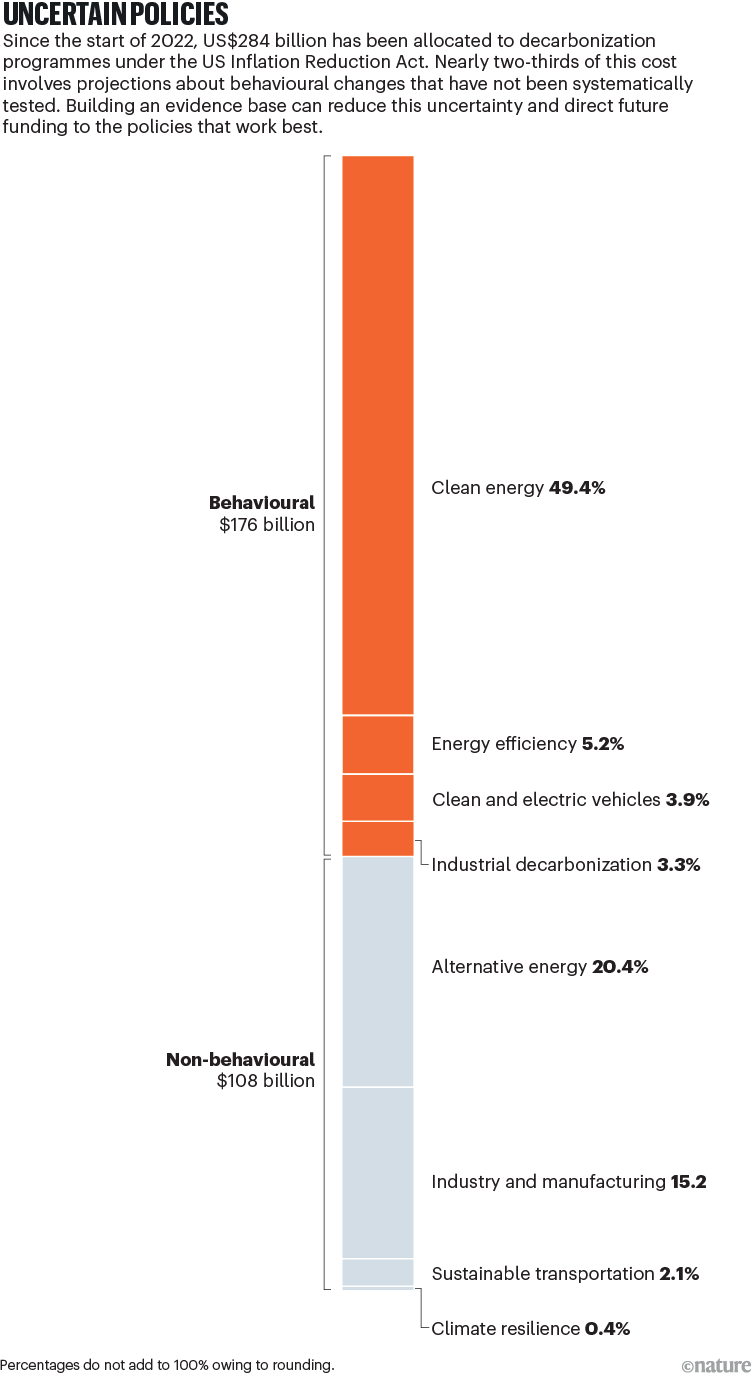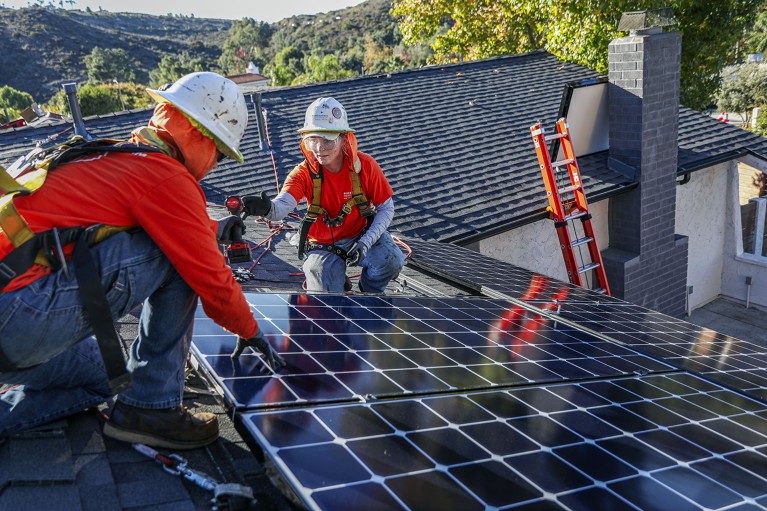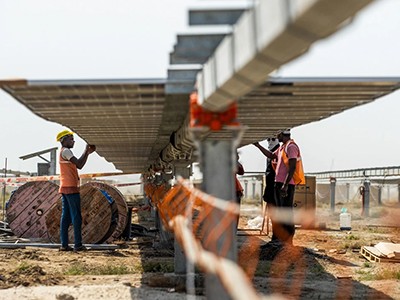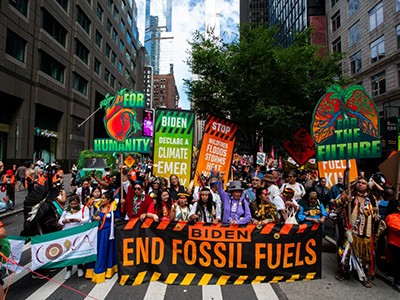Subsidizing people to buy electric vehicles can end up wasting money if they would have purchased one anyway.Credit: Paul Bersebach/MediaNews Group/Orange County Register via Getty
In the past three years, the United States has legislated to spend more than US$1 trillion on decarbonization. The Inflation Reduction Act (IRA) and the Bipartisan Infrastructure Law (BIL) focus that spending on policies that will accelerate the country’s transition to a low-carbon economy, such as tax credits for renewable energy and federal subsidies for electric vehicles.
For the most part, state and local governments will be implementing these policies. For example, states can establish programmes to oversee rebates for energy efficiency and electrification of housing and appliances from the $4.3-billion Home Owner Managing Energy Savings (HOMES) Program and the $4.5-billion High-Efficiency Electric Home Rebate Program. Building codes and land-use policies fall under the jurisdiction of thousands of local governments across the country.
Governments will face difficult choices about which programmes to prioritize and how to design them to maximize participation by households and businesses. There are many unknowns around changing people’s behaviour, including how to increase the use of public transportation, replace fossil-fuel heating technologies with electric alternatives and encourage farmers to adopt low-carbon practices.
Biases in ‘sustainable finance’ metrics could hinder lending to those that need it most
Partnering with researchers to evaluate the performance of decarbonization programmes and then improve them will be essential to ensuring that these investments achieve their greatest impact.
Researchers have much to gain, too. Tracking these interventions offers an unprecedented opportunity to learn about the efficacy, cost-effectiveness and the effects of a range of decarbonization programmes. Evidence from all these projects can guide further actions to achieve the nation’s 2050 greenhouse-gas-reduction commitments under the Paris climate agreement by committing to what works best. But this will be possible only if policies are designed and implemented in a way that allows such evaluations.
Here, we propose three principles that could improve the cost-effectiveness of IRA and BIL investments — properly incentivizing behaviour change, quantifying spillovers and evaluating trade-offs. We call on policymakers at all levels of government to use these and to work with researchers to establish an evidence base. And we propose three actions that will increase the value of the historic investment of the IRA and BIL, and guide future decarbonization efforts.
Target incentives to promote behaviour change
How well decarbonization will proceed depends on the capacity to change human behaviour. The IRA and BIL include a range of financial incentives designed to induce households and firms to adopt emerging technologies, change production and consumption practices, and adjust patterns of energy use to be more sustainable. For example, the IRA targets financial credits at electric vehicles, renewable-energy production and clean manufacturing. Three-fifths of these incentives are intended to sway behaviour, and how well they do so will affect the bill’s emissions-reduction potential (see ‘Uncertain policies’).

Source: Congressional Budget Office
The challenge for policymakers is how to target these incentives in the way that motivates behaviour change most effectively. That means focusing on those who need the incentives before they will take action, while avoiding unnecessary payments to those who would act without them. For example, it would be more effective to use subsidies to encourage someone who is undecided about buying an electric vehicle than to allocate the money to someone who has already bought one or plans to do so.
Yet this often happens. Researchers have found that recipients of energy-efficiency subsidies would have made the same investments at a lower subsidy level1. They have also revealed that 60–80% of Tesla electric cars purchased in California before 2018 would have been bought without a subsidy, despite most buyers having received one2. Those subsidies were therefore expensive, ranging from $25,000 to $52,000 per car. Such ill-targeted policies can waste public funds and increase decarbonization costs.
By identifying the groups that are most responsive to subsidies, governments can achieve carbon reductions at a lower cost. Policies might be differentiated on the basis of characteristics such as income or geographical location3,4. For example, in 2022, California imposed income caps on its electric-vehicle subsidies. An analysis of whether this had the intended effect of increasing uptake by targeted households would be helpful for other jurisdictions designing similar subsidies.
Similar targeting would be beneficial in other areas. For example, the US Weatherization Assistance Program provides free home energy-efficiency upgrades for low-income households. Subsidies targeted at specific types of housing stock can be more cost-effective than if they were made available universally5.
Extending the Sustainable Development Goals to 2050 — a road map
Isolating the impact of an intervention can be challenging without careful research designs and appropriate statistical approaches. For instance, simply comparing the level of adoption of electric cars in states with and without subsidies will overstate the role of subsidies, because states that offer them typically have high underlying demand for such vehicles. Many other factors — such as fuel and electricity prices, income and attitudes — can also influence the comparison and can be difficult to control for.
Therefore, we recommend that agencies deploying IRA and BIL funds integrate evaluation into programme designs from the earliest planning stage. By getting the design right from the start, the resulting evaluations will be more credible and can serve as models for future programmes to emulate or avoid.
There are many suitable research designs, with the gold standard being randomized controlled trials. Randomizing features of programme design or the timing of roll-out across groups or geographies can create clear comparison groups. When randomization is not feasible, methods such as comparing outcomes for otherwise equivalent groups just above and below an income-based threshold can isolate causal effects.
Unfortunately, the methods currently used to report programme impacts often do not enable credible accounting of the causal impacts of targeted programmes on emissions reductions. Collaborating with academic researchers provides a cost-effective way to access the expertise needed to build scientific consensus on optimal decarbonization strategies.
Quantify how policy actions accelerate learning
The development and diffusion of technologies, such as aircraft, semiconductors and wind turbines, often involve learning by doing. Typically, production costs decrease as experience accumulates, whether from one’s own efforts or from others’6,7. This process has implications for the short-term success or failure of technology adoption and for long-term economic growth8.
As with other public investments in research and development, decarbonization programmes can boost production experience, accelerate learning and drive down costs, to speed up technology adoption. The extent to which this occurs depends on the magnitude and scope of learning, the effectiveness of knowledge spillovers between firms and how well a given programme design facilitates learning.

The costs of installing solar panels will fall as workers gain and share experience.Credit: Sandy Huffaker/Bloomberg via Getty
In general, subsidies that target technologies that have greater potential for knowledge spillovers are likely to be more cost-effective. Research indicates, for example, that such spillovers have lowered costs in wind turbine production9 but had less impact among solar installers10. There is less evidence for the impacts of learning on other clean-energy sectors, such as lithium-ion batteries and green hydrogen. This knowledge gap limits the development of policy instruments that might be effective catalysts for deep decarbonization in the longer run.
We recommend that evaluations of learning be conducted as the IRA and BIL programmes are rolled out over time and across jurisdictions. These might provide evidence on how changes in manufacturing experience for lithium-ion batteries or wind turbines induced by the IRA and BIL programmes affect the unit cost of production, for example.
Similarly, learning in the installation phase of renewable technologies is important to understand. Armed with this knowledge, policymakers can improve their understanding of the cost-effectiveness of a range of decarbonization programmes and allocate funding to achieve superior decarbonization outcomes.
Measure trade-offs
By executive order, the White House has defined a goal that 40% of the overall benefits from the IRA and BIL should flow to communities that are “marginalized and overburdened by pollution” (see go.nature.com/3bgvcic). These objectives stem partly from evidence that clean-energy programmes, such as weatherization assistance, residential solar incentives and electric-vehicle subsidies, have typically gone disproportionately to homeowners and high-income households who can afford the cost11. Meanwhile, the air, water and land pollution associated with energy and transportation services and industrial activity disproportionately affect disadvantaged populations12.
To build a better world, stop chasing economic growth
Developing comprehensive evidence on decarbonization programmes requires evaluating various types of impact and differentiating the effects on vulnerable communities from those experienced elsewhere. For instance, tax credits for renewable electricity production by wind farms and for battery storage might generate jobs while mitigating urban air pollution. They might also place a disproportionate environmental burden on certain communities if battery-manufacturing plants emit lead or other toxic chemicals into the air. Failing to anticipate such trade-offs could lead to a distribution of subsidies and tax credits that exacerbates inequalities among communities, businesses and households.
To understand the distributional impacts of decarbonization programmes, it is important to identify the underlying drivers that explain variation in programme participation across different groups, as well as the indirect effects of such programmes on industrial pollution. Regular, systematic evaluation of how prioritized groups respond to available decarbonization programs could help to assess the importance of monetary and other barriers that might hinder uptake in disadvantaged communities, such as a lack of information, financial constraints, programme transparency or complexity. Removing such barriers could be cost-effective in increasing programme adoption.
Three action items
First, states and local governments need to develop a harmonized data-collection and monitoring infrastructure to guide their decarbonization programmes. Measuring and reporting outcome data from all programmes in the same way and using the same metrics is crucial to identifying the types of programme and policy that are most cost-effective. Collection of baseline data needs to start as soon as possible — measuring a programme’s impact usually requires knowing how things looked beforehand.
Decision makers need constantly updated evidence synthesis
Federal agencies should issue guidance or design data platforms to help harmonize data collection by states or local governments. One good example is the IRA’s Home Energy Rebates Program13. Harmonized data should be rich enough to be able to target low-income or other populations, and should be collected with enough frequency to be able to evaluate short-term and longer-term impacts after a programme has ended.
Second, we recommend prioritizing rigorous independent analysis by third-party researchers to ensure the credibility and transparency of evaluations of IRA and BIL programmes. As agencies develop their plans, they should seek opportunities to partner with researchers to shape methodological designs and data-collection strategies. Making anonymized microdata public allows independent parties to conduct their own research, leading to greater diversity of insights and maximizing opportunities for learning. This is consistent with the requirement for Open Data Plans under Title II of the Foundations for Evidence-Based Policymaking Act (see go.nature.com/4j3tgjp) and should become standard procedure.
Third, jurisdictions should share the outcomes of different interventions and coordinate their policy efforts. This will help state and local governments to avoid repeating mistakes previously made elsewhere. And jurisdictions can coordinate policy efforts to encourage reliable research practices, limit overlap between similar impact studies and explore why some policies are more cost-effective than others.
When historians look back at the energy transition of the twenty-first century, success will have been determined by an immense amount of learning from early attempts to stimulate the development and deployment of clean technologies. If effectively coordinated and evaluated, with the involvement of the scientific community, such efforts have the potential to inform decarbonization programmes around the world and achieve decarbonization at a manageable cost.






